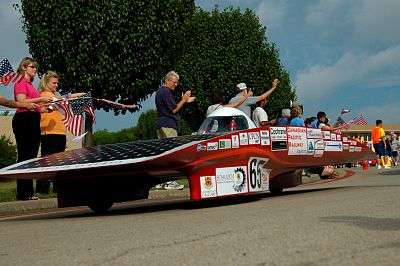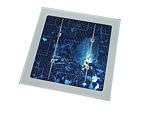Solar Team

The University of Calgary Solar Car Team is a multi-disciplinary student-run solar car racing ("raycing") team at the University of Calgary, based in Calgary, Alberta, Canada. It was established to design and build a solar car to compete in the American Solar Challenge (ASC) (previously named the North American Solar Challenge) and the World Solar Challenge (WSC). The team is primarily composed of undergraduate students studying Engineering, Business, Science, Arts and Kinesiology. The mission of the University of Calgary Solar Car Team is to educate the community about sustainable energy and to serve as an interdisciplinary project through which students and faculty from various departments can collaborate in supporting sustainable energy.
History
The University of Calgary Solar Car Team was established in the fall of 2004. The team was created to build a solar powered vehicle to complete in the 2005 North American Solar Challenge.

Soleon
Miracle workers
The team performed a "miracle" by managing to establish a strong student base with which to construct the car, procure significant sponsorship and successfully build a highly successful vehicle with limited experience all in approximately 9 months. Established teams have two years to refine existing designs between rayces.
The X1 (prototype)
In preparation for its first rayce, the University of Calgary Solar Team constructed and tested a prototype of their designs before building the final car. The X1 was a mock-up of and predecessor to Soleon. The X1 was used for driver training and allowed the team to test various design decisions to help ensure a successful final product. The X1 was constructed from a steel chassis with a fibreglass shell which was coated with gelcoat which made the vehicle approximately twice the final weight of its sister car.
First race results
In its first year of existence the University of Calgary Solar Team successfully competed in the NASC and the WSC. In the 2005 NASC, Soleon, their first generation rayce car placed 13th out of 17 cars that made it to the finish line. In the 2005 WSC Soleon placed 10th overall (out of 18) and first in its class. After hearing about this success, Seymour Schulich was inspired to donate $25 million (another $25 million was matched by the Alberta government) to the University of Calgary Engineering department, which was renamed the Schulich School of Engineering.
Schulich I
2007 WSC race
Since the success of Soleon in the 2005 races, the team had to redesign for the new regulations for WSC, and prepare for the harder competition it faced from changing class to the higher, more competitive Challenge class. This class included higher efficiency solar cells, upright seating, and teams that had been raycing for the last 20 years. After shipping their new car to Australia, and testing it before scrutineering, the car had a rear tire blow out on the race track in Darwin, and resulted in the car spinning around having the tail section impacting into the guard rail and ripped from the car. The team then had to rebuild and redesign the tail section in one night before racing. Despite the higher competition and race track crash, the team managed to be the first (of six) Canadian teams to cross the timing finish line, finish 8th (out of 19) in the Challenge class, and 15th (out of 37) overall.
2008 NASC race
Schulich I was improved after WSC 2007 for racing in the 2008 North American Solar Challenge. The rayce from Dallas, Texas to Calgary lasted ten days, with the University of Calgary Solar Team placing 6th (out of 15).
Schulich Axiom
2010 ASC
The University of Calgary's 3rd generation car, Schulich Axiom, was first raced in the 2010 ASC. The race spanned 1770 km from Tulsa, Oklahoma to Chicago, Illinois. The team finished in 6th place (of 18 teams) and received both the Sportsmanship and Mechanical Engineering awards for the race. With regulation changes for the 2011 WSC, the team re-engineered the design of Schulich Axiom and completely rebuilt the solar car. Some of the changes made include switching to silicon solar cells and reducing the weight of the car.[1]
2011 WSC
The 2011 WSC takes place October 16–23, 2011 and runs from Darwin, Northern Territory to Adelaide, South Australia. The University of Calgary Solar Team has entered Schulich Axiom in the race.
Achievements
| Year | Vehicle | Achievements |
|---|---|---|
| 2005 | Soleon | 1st Place Stock Class WSC 2005 |
| 10th Place Overall WSC 2005 | ||
| 13th Place Overall NASC 2005 | ||
| Top Canadian Team at WSC 2005 | ||
| Best Rookie Team, Teamwork and Esprit de Corps Awards at NASC 2005 | ||
| 2007 | Schulich I | First of six Canadian teams to cross timing finish line |
| 8th Place in Challenge Class WSC 2007 | ||
| 15th Place Overall WSC 2007 | ||
| 2008 | Schulich I | 6th Place Overall NASC 2008 |
| 2010 | Schulich Axiom | 6th Place Overall ASC 2010 |
| Award for Mechanical Engineering Excellence ASC 2010 | ||
| Award for Sportsmanship ASC 2010 (Shared with two other teams) |
Schulich Delta
Design and construction
Schulich Delta was designed over the course of eight months, and construction took another three months. Delta was a radical departure for the team, featuring two doors, four wheels, a passenger seat and cargo space for the very first time.
2013 WSC
The team has entered Schulich Delta to compete in the Cruiser class in the 2013 World Solar Challenge from October 6–13, 2013.
Cars
X1 (prototype)
Maximum Achieved Speed: ~70 km/h
Solar Array Type: none (stickers merely for show)
Chassis: Steel Space frame
Shell Composition: Fibreglass & Gelcoat
Commissioned: May 2005
Decommissioned: June 2006
Current Uses: X1 has been decommissioned. The chassis is all that remains. It is suspended against a wall in the University of Calgary Solar Team's workshop.

Soleon
Maximum Achieved Speed: 140 km/h
Solar Array Type: Silicon
Chassis: Aluminum Space frame
Shell Composition: Carbon Fiber & Kevlar
Weight: ~500 lbs
Commissioned: June 2005
Decommissioned: July 2007
Current Uses: In the fall of 2008 Soleon was donated to the Calgary Telus World of Science and was on display for 2 years. Soleon is now retired and looking for a nice warm garage to rest.
Schulich I
Maximum Achieved Speed: 105 km/h
Solar Array Type: Gallium arsenide (GaAs) Triple-junction
Chassis: Steel Space frame
Shell Composition: Carbon Fiber & Kevlar
Weight: ~520 lbs
Commissioned: September 2007
Decommissioned: May 2011
Current Uses: Participated in the 2007 Panasonic World Solar Challenge and the 2008 North American Solar Challenge. Since Axiom is now being used for driver training, mechanical testing and PR events, Schulich I has been retired.

Schulich Axiom (2010)
Maximum Achieved Speed: 130 km/h
Solar Array Type: Gallium arsenide (GaAs) Triple-junction
Chassis: Carbon Fiber & Kevlar
Shell Composition: Carbon Fiber & Kevlar
Weight: ~600 lbs
Commissioned: October 2009
Current Uses: Placed 6th overall in the 2010 North American Solar Challenge. Schulich Axiom (2010) is now predominantly being used as a display vehicle.

Schulich Axiom (2011)
Maximum Achieved Speed: 110 km/h
Solar Array Type: Silicon Monocrystalline (Si) UC Solar Embedded
Chassis: Carbon Fiber
Shell Composition: Carbon Fiber
Weight: ~390 lbs
Commissioned: May 2011
Current Uses: Planning on racing in the 2011 World Solar Challenge. All improvements have since been completed to Schulich Axiom. "It is evident from the previous race that weight is no minor detail. We have taken Axiom on its diet and the result is stunning. Axiom has dropped from around 600 lbs. without driver and ballast to 390 lbs. A loss of 210 lbs!" -Mico Madamesila
References
- ↑ The car was unveiled November 2009 to a sold out crowd at the Fairmont Palliser Hotel in Calgary, Alberta.
